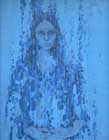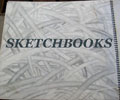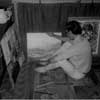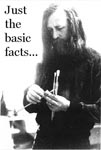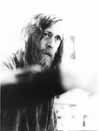
10.Throughout his life, Bob remained true to his artistic and philosophical ideals, and always encouraged others in their pursuit of creative or intellectual aspirations. He got on particularly well with young people. Daughter Jess, who co-founded Sydney metal band Nitocris at the age of 14, said "Bob was a huge influence on Nitocris. He had faith in us right from the start. He opened our minds in so many ways, like heaps of music, stuff we wouldn't have considered, talk and jokes and lots of support".
In 1998 Bob and his last wife Anne moved with a dog and six cats to Glenfield in Sydney's south-west. Unfortunately Bob's health was in decline and he endured a painting "drought" towards the end of the decade, although he continued to draw and write poems and skits. He died at Liverpool Hospital in March 2001, aged 60.
8.At the end of the 1970s Bob, Lynne and their daughters moved to Hunter's Hill in Sydney's inner west, and in 1982 slightly further west to Boronia Park where they stayed till 1987. Their houses were gathering places for an extended family of friends, the odd relative, and children. Although he had ceased exhibiting, Bob sold works privately (or gave them away to fans). He would have a painting or two in progress most of the time, and many more in his mind's eye. He took little notice of prevailing trends, and admired only a few of his contemporaries. He wrote: " I belong to no school of painting and have a deeply rooted distrust of manifestos and 'isms'...I have the whole history of painting behind me and I want it all.. I paint to safeguard the future of vision."
4.In 1958 Bob was apprenticed as a signwriter and in his final year became NSW (State) Signwriting Apprentice of the Year. He took painting lessons with the eminent Meldrum school artist Graeme Inson, whilst working as a signwriter and reading widely. He gathered a large library of books on art, philosophy, evolution, anthropology and literature from Sydney's second-hand bookshops. He also collected objects, many of which appeared in his still lifes.
Bob rented a studio in the Haymarket and created works that reflected the Meldrum-style techniques taught by Inson with a strong emphasis on tonal values. Inson was a mentor as well as a teacher and Bob was much influenced by him personally as well as artistically.
In late 1970 Bob and his second wife Lynne moved to Stanwell Park, a seaside village just south of Sydney. They then moved a bit further south to Coalcliff, where daughter Amara was born in 1971.
7.The dramatic Illawarra escarpment and south coast landscape inspired and were drawn upon in a range of Bob's works, in the 1970s and later years. In 1974 he and Lynne, with Amara, moved back to Balmain where second daughter Jessamine (Jess) was born in 1977. Bob's artworks during this decade became more vivid and dramatic, and whilst remaining true to Meldrum principles, diverged gradually and widely into uncharted areas of subject matter, also becoming more experimental in tone, form and colour.
5.Bob had works hung in the Archibald and Sulman Prize exhibitions at the Art Gallery of NSW in the mid-1960s, and then had several solo shows in the Sydney CBD.
Sometime in the 1960s he stopped signing his paintings, believing the signature rested in the work itself.
In the mid to late 1960s Bob and his first wife, the poet Vicki Viidikas, lived in King's Cross then in Balmain (suburbs of Sydney) where literary and artistic life was flourishing, and new ideas and experimentation were eagerly pursued. Bob, who had first encouraged Vicki to take her writing seriously, became involved alongside her in the Poetry Society of Australia through their friend Robert Adamson. Keith Finlayson had become a blues musician and performed at poetry readings. Bob took up the role of art editor for the rejunvenated Poetry Magazine, designing the covers. He also designed the cover for one of Robert Adamson's early poetry collections, Swamp Riddles.
2.Bob went to school at Cronulla, a southern beachside suburb then on Sydney's fringe. He didn't particularly enjoy school, and sometimes didn't go, but did reasonably well academically, and excelled at sport. He was part of the team that won the six-stone rugby league premiership in 1954, and also represented Sydney Schoolboys in league. He had fond memories of one particular teacher who encouraged him to draw and paint and gave him art materials. Bob took on a paternal role with his younger brother Keith (born 1950) due to their father's erratic and sometimes violent habits. Their older brother, John, was sent to the Catholic youth home Boys' Town in his early teens, after a fight with his father, and the family never saw him again.
3. Bob left school at 15 and was offered a place as fullback in the Balmain Rugby League's third grade team. He didn't take this up, but sport continued to be part of his life. He played first grade cricket for St George, and before and after that, A grade for Kogarah. At 19 or 20 he was invited to join the State practice squad in cricket (an offer he had to decline due to work and painting commitments). He also enjoyed rowing, boxing, golf, table tennis and horse-riding, and was a talented pool and snooker player.








